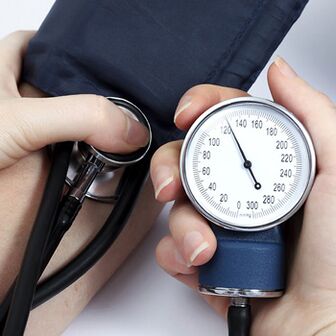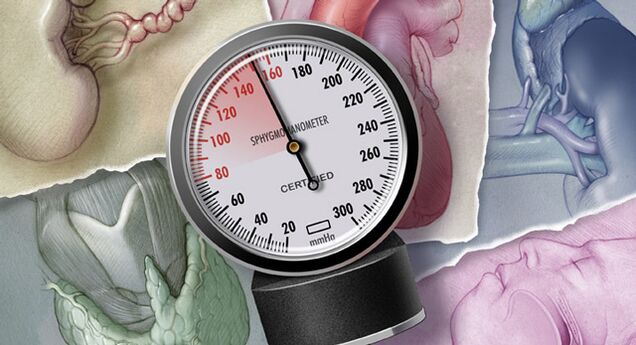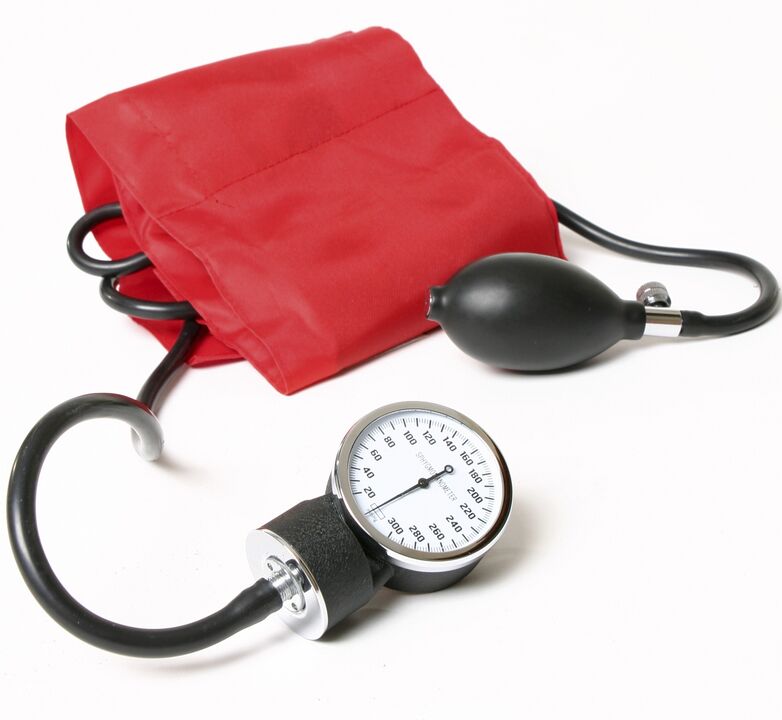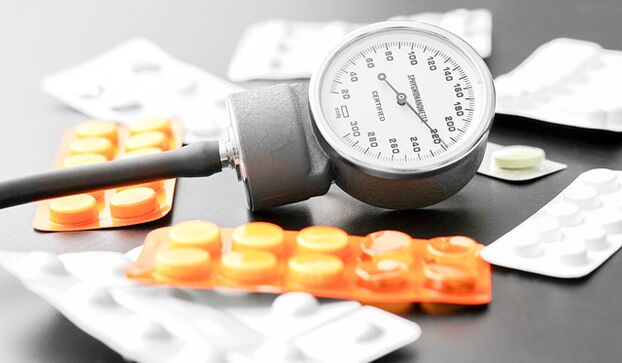
Hypertension (HTN) is one of the most common diseases of the cardiovascular system, affecting only one-third of the world's population, according to approximate data. At the age of 60-65, more than half of the population is diagnosed with hypertension. This disease is called the "silent killer", because its signs can be absent for a long time, while changes in the walls of blood vessels already begin in the asymptomatic stage, significantly increases the risk of stroke.
In Western literature, this disease is called arterial hypertension (AH). Others have adopted this formulation, although both "hypertension" and "hypertension" are still commonly used.
Close attention to the problem of arterial hypertension is caused not by its clinical manifestations but by complications in the form of acute vascular disorders of the brain, heart and kidneys. Their prevention is the main goal of treatment to maintain normal blood pressure (BP).
An important point is to identify all possible risk factors,as well as elucidate their role in disease progression. The relationship between the degree of hypertension and the existing risk factors is shown in the diagnosis, which simplifies the assessment of the patient's condition and prognosis.
For most patients, the numbers in the diagnosis after "AH" do not mean anything, although it is clear that the higher the level and risk index, the worse the prognosis and the more severe the pathology. In this article we will try to understand how and why one degree of hypertension is diagnosed and what is the basis for determining the risk of complications.
Causes and risk factors for high blood pressure
The causes of arterial hypertension are many. GovernmentTalking about primary or essential hypertension, we andWe mean the absence of a specific previous disease or pathology of the internal organs. In other words, such hypertension occurs on its own, involving other organs in the pathological process. Primary hypertension accounts for more than 90% of chronic high blood pressure cases.
The main cause of primary hypertension is believed to be stress and psychological-emotional overload, contributing to disturbances in the central pressure regulation mechanism in the brain, and then humoral mechanisms are affected. affected and affected target organs (kidney, heart, retina).

Secondary hypertension– manifestation of another disease so always know the cause. It is accompanied by diseases of the kidneys, heart, brain, endocrine disorders and is a secondary disease afterwards. After the underlying disease is cured, hypertension also disappears, so determining the risk and extent in this case is meaningless. Symptomatic hypertension accounts for no more than 10% of cases.
Risk factors for high blood pressure are well known. Hypertension schools are being established in clinics, where experts convey information to people about adverse conditions that lead to hypertension. Any therapist or cardiologist will tell a patient about the risks from the first documented case of high blood pressure.
Among the conditions that have a risk of causing high blood pressure, the most important are:
- Smoke;
- Excess salt in food, drinking too much liquid;
- Insufficient physical activity;
- Alcohol abuse;
- Overweight and fat metabolism disorders;
- Chronic psychological and emotional overload.
If we can eliminate the listed factors or at least try to reduce their impact on health, then characteristics such as gender, age, genetics cannot be changed and therefore theyWe will have to confront them, but without forgetting the ever-increasing risks.
Classify arterial hypertension and determine the level of risk
Classifying hypertension includes determining the stage and severity of the disease and the risk of stroke.
Disease stagedepends on clinical manifestations. Highlights:
- Preclinical stage, when there are no signs of increased blood pressure and the patient does not know the blood pressure is increased;
- Stage 1 hypertension, when blood pressure is high, acute attacks may occur but there are no signs of target organ damage;
- Stage 2 is accompanied by damage to target organs - myocardial hypertrophy, pronounced changes in the retina of the affected eye and kidneys;
- In stage 3, stroke, myocardial ischemia, vision problems, and large blood vessel changes (aortic aneurysm, atherosclerosis) may occur.
Degree of hypertension
Determining the degree of hypertension is important in assessing risk and prognosis and is based on pressure data. It must be said that normal blood pressure values also have different clinical meanings. So, the indicator is up to 120/80 mm Hg. Art. countOptimal,NormalBlood pressure will be between 120-129 mmHg. Art. systolic and 80-84 mm Hg. Art. diastolic. Blood pressure number 130-139/85-89 mmHg. Art. still within normal limits but are approaching the pathological border, which is why they are called "very normal", and the patient may be told that he or she has high-normal blood pressure. These signs may be considered premorbid, as the pressure is only "a few millimeters" away from increasing.

Since blood pressure reached 140/90 mm Hg. Art. we can already talk about the presence of this disease. This index is used to determine the degree of hypertension:
- Stage 1 hypertension (HTN or AH stage 1 at diagnosis) means pressure increases between 140-159/90-99 mmHg. Art.
- Stage 2 headache is accompanied by the numbers 160-179/100-109 mm Hg. Art.
- With stage 3 hypertension, blood pressure is 180/100 mmHg. Art. and higher.
What happens is that the systolic blood pressure reading increases, up to 140 mm Hg. Art. and higher, while the diastolic value is within the normal value. In this case they talk aboutsolitary systolic formhypertension. In other cases, the indicators of systolic and diastolic blood pressure correspond to different degrees of the disease, then the doctor will make a diagnosis in favor of a higher degree and prescribe it. It doesn't matter whether the conclusion is based on systolic or diastolic blood pressure.
The most accurate diagnosis of the severity of hypertension can be made when the disease is first diagnosed, when no treatment has been initiated and the patient has not taken any antihypertensive drugs. During treatment, the amount decreases, when stopping use, on the contrary, it can increase sharply, so it is impossible to fully assess the level.
The concept of risk in diagnosis
Hypertension is very dangerous due to its complications. It is no secret that the vast majority of patients die or become disabled not from high blood pressure but from the acute disorders it leads to.
Cerebral hemorrhage or ischemic necrosis, myocardial infarction, and kidney failure are the most dangerous conditions caused by high blood pressure. In this regard, for each patient after a thorough examinationThe risk is determined, expressed in the diagnosis by the numbers 1, 2, 3, 4. Thus, the diagnosis is based on the degree of hypertension and the risk of vascular complications (eg hypertension/hypertension). Pressure stage 2, risk 4).
Risk stratification criteriaFor hypertensive patients, external conditions, the presence of other diseases and metabolic disorders, the involvement of target organs and concomitant changes in organs and systems are used. use.
Major risk factors that affect prognosis include:
- Patient age is after 55 years old for men and 65 years old for women;
- Smoke;
- Lipid metabolism disorders (cholesterol exceeding normal levels, low-density lipoprotein, reduced proportion of high-density lipids);
- Presence of cardiovascular disease in the family among blood relatives under 65 years of age for women and 55 years of age for men, respectively;
- Excess body weight, when abdominal circumference exceeds 102 cm in men and 88 cm in women.
The listed factors are considered the main ones, but many hypertensive patients have diabetes, impaired glucose tolerance, lead a sedentary lifestyle and have abnormalities in the coagulation system in the form of increased blood pressure. fibrinogen concentration. These factors consideraddalso increases the likelihood of complications.
Damage to target organs characterizes hypertension, starting from stage 2 and serves as an important criterion for determining risk, therefore, the patient's examination includes ECG, echocardiography toDetermine the degree of muscle hypertrophy, blood and urine tests to find kidney function indicators (creatinine, protein).
First of all, the heart has high blood pressure, pushing blood into the vessels with greater force. As arteries and arterioles change, as their walls lose elasticity and their lumens become constricted, the load on the heart gradually increases. A characteristic feature that is taken into account when considering risk stratificationmyocardial hypertrophy, may be suspected by ECG, can be determined by ultrasound examination.
Involvement of the kidney as the target organ is indicated by an increase in creatinine in the blood and urine as well as the appearance of albumin protein in the urine. In the context of hypertension, the walls of large arteries thicken, atherosclerotic plaques appear, which can be detected by ultrasound (carotid artery, brachial artery).
The third stage of hypertension occurs with associated pathology, that is, associated with hypertension.Among the diseases involved, the most important prognostic are stroke, transient ischemic attack, myocardial infarction and angina, diabetic nephropathy, renal failure, retinopathy (damage to the retina) due to increased blood pressure.
So the reader can understand how you can independently determine the degree of headache. This is not difficult, you just need to measure the pressure. Next, you can think about the presence of certain risk factors, taking into account age, gender, laboratory parameters, ECG data, ultrasound, etc. v. In general, everything is listed above.
For example, a patient's blood pressure corresponds to stage 1 hypertension, but at the same time he has a stroke, that is, the risk will be maximum – 4, even if stroke is the only problem besides increasedblood pressure. If the pressure corresponds to the first or second degree and the only risk factors that can be noted are smoking and age against a background of fairly good health, then the risk will be moderate -1 tbsp. (2 tbsp. ), risk 2.
To further clarify the meaning of the risk indicator in diagnostics, you can summarize everything in a small table. By determining the level and "counting" the above factors, you can determine the risk of stroke and hypertensive complications for a particular patient. Number 1 means low risk, 2 – moderate, 3 – high, 4 – very high risk of complications.
| Risk factors | BP 130-139/85-89, risk | GB (AH) 1, risk | GB 2, risk | GB 3, risk |
|---|---|---|---|---|
| Not available | first | 2 | 3 | |
| 1-2 | first | 2 | 2 | 4 |
| more than three factors/target lesions/diabetes | 3 | 3 | 3 | 4 |
| related pathology | 4 | 4 | 4 | 4 |
Low risk means that the probability of a stroke is no more than 15%, medium - up to 20%, high risk indicates the development of complications in 1/3 of patients in this group, withvery high risk of more than 30% of patients being susceptible to complications.
Symptoms and complications of headaches
Symptoms of hypertension are determined by the stage of the disease. In the pre-clinical stage, the patient feels well and only blood pressure measurements show that the disease is developing.

As changes in blood vessels and the heart progress, symptoms appear in the form of headaches, weakness, decreased performance, periodic dizziness, visual symptoms in the form of impaired vision, "spots"flashing before my eyes. All these signs are not manifested during a stable pathological process, but at the moment of the development of a hypertensive crisis, the clinic becomes brighter:
- Severe headache;
- Noise, ringing in the ears or ringing in the ears;
- Eye dark circles;
- Pain in the heart area;
- Shortness of breath;
- Facial hyperemia;
- Excitement and a sense of fear.
Hypertensive attacks are provoked by traumatic situations, overwork, stress, drinking coffee and alcoholic beverages, so patients with a confirmed diagnosis should avoid such influences. . In the context of a hypertensive crisis, the likelihood of complications increases sharply, including life-threatening ones:
- Cerebral hemorrhage or infarction;
- Acute hypertensive encephalopathy, which may be accompanied by cerebral edema;
- Pulmonary edema;
- Acute kidney failure;
- Heart attack.
How to measure blood pressure accurately?
If there is reason to suspect high blood pressure, the first thing your specialist will do is measure your blood pressure. Until recently, it was believed that blood pressure measurements can often be different in different hands, but, as practice has shown, there are even differences of up to 10 mm Hg. Art. can occur due to pathology of peripheral blood vessels, therefore caution is needed when dealing with different pressures on the right and left hand.

To get the most reliable readings, pressure should be measured three times on each arm at short intervals, record each result obtained. In most patients, the smallest values obtained are the most accurate, but in some cases the pressure increases from one measurement to another, which is not always beneficial for hypertensive disorders. blood pressure.
The wide choice and availability of blood pressure measuring devices makes it possible to monitor blood pressure in many people at home. Usually, hypertensive patients have a blood pressure monitor available at home so that if their health condition worsens, they can measure their blood pressure immediately. However, it is worth noting that fluctuations can also occur in completely healthy people without hypertension, so even slightly exceeding the normal level is not considered a disease and toTo diagnose hypertension, blood pressure must be measured at different times. , under different and repeated conditions.
When diagnosing hypertension, blood pressure data, electrocardiogram data, and auscultation results are considered basic. When listening, noise, increased sound, and arrhythmia can be detected. The ECG, starting from the second phase, will show signs of stress on the left side of the heart.
Treatment of hypertension
To regulate high blood pressure, treatment regimens have been developed that include drugs of different classes and different mechanisms of action. TheirThe combination and dosage are selected individually by the doctortaking into account the stage, comorbidities and response of hypertension to a specific drug. After the diagnosis of hypertension is established and before starting drug treatment, the doctor will recommend non-pharmacological measures that significantly increase the effectiveness of pharmacological drugs and sometimes allow you to reduce the dose of the drug. or quit at least some of them.
First of all, it is recommended to normalize the regimen, eliminate stress and ensure physical activity. The diet is aimed at reducing salt and fluid intake, eliminating alcohol, coffee, drinks and nervous system stimulants. If you are overweight, you should limit calories and avoid fatty, floury, fried and spicy foods.
Non-pharmacological measures in the early stages of hypertension may be so effective that the need to prescribe medication will no longer be necessary. If these measures are ineffective, your doctor will prescribe appropriate medication.
The goal of treating hypertension is not only to reduce blood pressure but also to eliminate the cause of the disease, if possible.

Antihypertensive drugs of the following groups are commonly used to treat hypertension:
- Diuretic;
- Angiotensin II receptor antagonist;
- ACE inhibitors;
- Adrenergic blockers;
- Calcium blockers.
Every year the list of drugs that lower blood pressure grows, becoming more effective and safer, with fewer side effects. At the beginning of treatment, a drug is prescribed in a minimum dose, otherwise the effectiveness may increase. If the disease progresses and the pressure does not remain at an acceptable level, another drug from another group will be added to the first drug. Clinical observations show that the effectiveness of combination therapy is better than prescribing a single drug at the maximum dose.
Reducing the risk of vascular complications is important in choosing a treatment regimen.So, it was noted that some combinations have a more pronounced "protective" effect on organs, while others allow better pressure control. In such cases, experts prefer a combination of medications that reduce the likelihood of complications, even if blood pressure has some day-to-day fluctuations.
In some cases, it is necessary to take into account accompanying diseases to adjust the headache treatment regimen. For example, men with prostate tumors are prescribed alpha blockers, which are not recommended for continuous use to reduce blood pressure in other patients.
ACE inhibitors, the most widely used calcium channel blockers,are prescribed to both young and elderly patients, with or without concomitant diseases, diuretics, sartan drugs. Drugs in these groups are suitable for initial treatment, which can then be supplemented with a third drug with a different composition.
ACE inhibitors reduce blood pressure and also protect the kidneys and heart muscle. They are more appropriate in younger patients, women taking hormonal contraceptives, indicated for diabetes, and elderly patients.
Diureticno less popular. To reduce adverse reactions, they are combined with ACE inhibitors, sometimes "in one pill".
Beta blockersnot a priority group for treating hypertension but effective for accompanying heart disease - heart failure, tachycardia, coronary artery disease.
Calcium blockersOften prescribed in combination with ACE inhibitors, they are especially good for bronchial asthma combined with hypertension because they do not cause bronchospasm.
Angiotensin receptor antagonists– the most commonly prescribed group of drugs for hypertension. They reduce blood pressure effectively and do not cause coughing like many ACE inhibitors. But in the US they are especially popular due to a 40% reduced risk of Alzheimer's disease.
When treating hypertension, it is important not only to choose an effective regimen, but also to use the drug for a long time, even for life. Many patients believe that when the pressure reaches normal levels, treatment can be stopped, but they take medication at a critical moment. It is known that non-systematic use of antihypertensive drugs is even more harmful to health than complete absence of treatment, therefore, informing the patient about the duration of treatment is one of the tasks. doctor's importance.





























